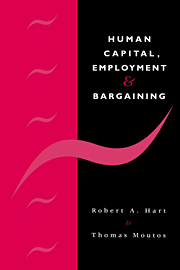Book contents
- Frontmatter
- Contents
- Preface
- 1 Overview
- 2 Labour demand and efficient contract models
- 3 Turnover costs, firm-specific training and unemployment
- 4 Employment and bargaining
- 5 Choice of compensation, unemployment insurance and policy issues
- 6 Team-related human capital and bargaining
- 7 Coalitional versus neoclassical firms
- 8 Future developments
- Bibliography
- Index
3 - Turnover costs, firm-specific training and unemployment
Published online by Cambridge University Press: 05 November 2011
- Frontmatter
- Contents
- Preface
- 1 Overview
- 2 Labour demand and efficient contract models
- 3 Turnover costs, firm-specific training and unemployment
- 4 Employment and bargaining
- 5 Choice of compensation, unemployment insurance and policy issues
- 6 Team-related human capital and bargaining
- 7 Coalitional versus neoclassical firms
- 8 Future developments
- Bibliography
- Index
Summary
Turnover costs and firm-specific training in a macroeconomic perspective
In chapter 2, we have reviewed a number of important labour market issues – at the level of the microeconomics of the firm – in which firm specific human capital investment plays a central role. When aggregating firms into industries and examining the macroeconomic implications of changes in policy and other variables, does the concept of investment specificity retain its significance? In particular, does it contribute to our understanding of unemployment? The existing literature has relatively little to say on this and other macroeconomic topics. The main purpose of this chapter is to investigate the consequences of specific human capital investments and their associated turnover costs for the equilibrium unemployment rate.
Labour costs can be divided into fixed and variable components. Fixed costs are per-worker costs – both once-over and recurrent – that do not vary with the degree of labour utilisation. Hart (1984) and Hamermesh (1993) provide comprehensive typologies. Turnover costs constitute a sub-set of once-over fixed costs and refer to the firm's monetary costs of changing employment, with respect to both outgoing and incoming employees. They also involve direct and indirect elements (Salop, 1979). Examples of direct costs include redundancy payments, golden hand shakes, search/screening/recruitment expenditures, job orientation programmes and company training schemes while indirect costs involve productivity losses due to the disruption and dislocation of work schedules and organisation.
- Type
- Chapter
- Information
- Human Capital, Employment and Bargaining , pp. 48 - 76Publisher: Cambridge University PressPrint publication year: 1995



